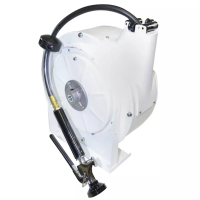Lit. No. 68660/68661, Rev. 04 14 January 15, 2014
Variable Speed Control
Starting and Stopping the Motor
1. Turn the control ON to start the motor. The motor
will start immediately. The power switch will
remain in the "ON" position. The spreader will
operate at the speed selected on the speed dial.
2. To increase the speed of the spinner, turn the
speed dial clockwise.
3. To decrease the speed of the spinner, turn the
speed dial counterclockwise.
4. Turn the control OFF to stop the motor. The power
switch will remain in the "OFF" position.
The ON/OFF switch operates as an emergency
stop when required.
NOTE: The truck ignition must be ON to start the
spreader.
NOTE: If the truck ignition is turned OFF while the
spreader is running, the motor will stop.
NOTE: Always place the cover on the hopper to
prevent moisture buildup. Do not let the spreader
sit idle with material in the hopper for an extended
period of time. This can cause the material to
compact and reduce or stop the ow of material.
OPERATING THE SPREADER
WARNING
Before starting the spreader, the driver shall
verify that all bystanders are a minimum of
25 feet away from operating spreader.
Indicator Lights (Show actual motor
speed relative to total speed range.)
ON/OFF Switch
(e
mergency stop when required)
DRIVING AND SPREADING ON SNOW
AND ICE
Follow your vehicle owner's manual instructions for
driving in snow and ice conditions. Remember, when
you drive on snow or ice, your wheels will not get good
traction. You cannot accelerate as quickly, turning
is more difcult, and you will need longer braking
distance. Wet and hard packed snow or ice offer the
worst tire traction. It is very easy to lose control. You
will have difculty accelerating. If you do get moving,
you may have poor steering and difcult braking,
which can cause you to slide out of control.
Here are some tips for driving in these conditions:
• Drive defensively.
• Do not drink, then drive or spread ice‑control
materials.
• Spread or drive only when you have good visibility
for operating a vehicle.
• If you cannot see well due to snow or icy
conditions, you will need to slow down and keep
more space between you and other vehicles.
• Slow down, especially on higher‑speed roads.
Your headlamps can light up only so much road
ahead.
• If you are tired, pull off in a safe place and rest.
• The spreader's size and location reduce driver
visibility to the rear of the vehicle. We recommend
an OSHA‑compliant backup alarm for all governed
employers.
• Keep your windshield and all glass on your vehicle
clean to see around you.
• Dress properly for the weather. Wear layers of
clothing; as you get warm, you can take off layers.
CAUTION
Drinking and then driving or spreading is
very dangerous. Your reexes, perceptions,
attentiveness and judgment can be affected
by even a small amount of alcohol. You can
have a serious or even fatal collision if you
drive after drinking. Please do not drink then
drive or spread ice-control materials.

